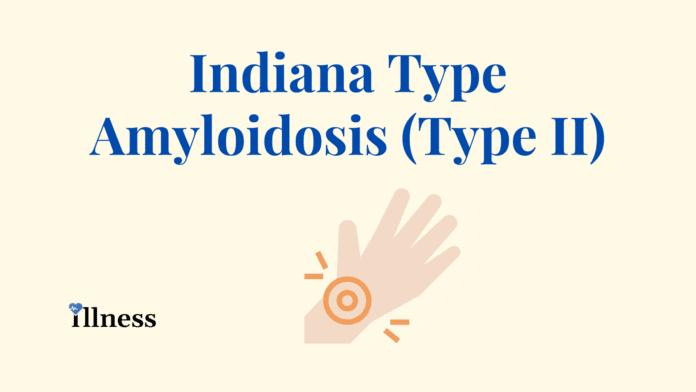Overview Of Indiana Type Amyloidosis (Type II)
Indiana Type Amyloidosis (Type II) is synonymous with transthyretin amyloidosis. This disease is a slowly progressive condition characterized by the buildup of abnormal deposits of a protein called amyloid (amyloidosis) in the body’s organs and tissues. These protein deposits most frequently occur in the peripheral nervous system, which is made up of nerves connecting the brain and spinal cord to muscles and sensory cells that detect sensations such as touch, pain, heat, and sound. Protein deposits in these nerves result in a loss of sensation in the extremities (peripheral neuropathy). The autonomic nervous system, which controls involuntary body functions such as blood pressure, heart rate, and digestion, may also be affected by amyloidosis. In some cases, the brain and spinal cord (central nervous system) are affected. Other areas of amyloidosis include the heart, kidneys, eyes, and gastrointestinal tract. The age at which symptoms begin to develop varies widely among individuals with this condition and is typically between ages 20 and 70.
There are three major forms of transthyretin amyloidosis, which are distinguished by their symptoms and the body systems they affect.
The neuropathic form of transthyretin amyloidosis primarily affects the peripheral and autonomic nervous systems, resulting in peripheral neuropathy and difficulty controlling bodily functions. Impairments in bodily functions can include sexual impotence, diarrhea, constipation, problems with urination, and a sharp drop in blood pressure upon standing (orthostatic hypotension). Some people experience heart and kidney problems as well. Various eye problems may occur, such as cloudiness of the clear gel that fills the eyeball (vitreous opacity), dry eyes, increased pressure in the eyes (glaucoma), or pupils with an irregular or “scalloped” appearance. Some people with this form of transthyretin amyloidosis develop carpal tunnel syndrome, which is characterized by numbness, tingling, and weakness in the hands and fingers.
The leptomeningeal form of transthyretin amyloidosis primarily affects the central nervous system. In people with this form, amyloidosis occurs in the leptomeninges, which are two thin layers of tissue that cover the brain and spinal cord. A buildup of protein in this tissue can cause stroke and bleeding in the brain, an accumulation of fluid in the brain (hydrocephalus), difficulty coordinating movements (ataxia), muscle stiffness, and weakness (spastic paralysis), seizures, and loss of intellectual function (dementia). Eye problems similar to those in the neuropathic form may also occur. When people with leptomeningeal transthyretin amyloidosis have associated eye problems, they are said to have the oculoleptomeningeal form.
The cardiac form of transthyretin amyloidosis affects the heart. People with cardiac amyloidosis may have an abnormal heartbeat (arrhythmia), an enlarged heart (cardiomegaly), or orthostatic hypertension. These abnormalities can lead to progressive heart failure and death. Occasionally, people with the cardiac form of transthyretin amyloidosis have mild peripheral neuropathy.
Commonly Associated With
- Portuguese polyneuritic amyloidosis
- Portuguese type familial amyloid neuropathy
- Swiss type amyloid polyneuropathy
- type I familial amyloid polyneuropathy
- type II familial amyloid polyneuropathy
Causes Of Indiana Type Amyloidosis (Type II)
Mutations in the TTR gene cause Indiana Type Amyloidosis (Type II). The TTR gene provides instructions for producing a protein called transthyretin. Transthyretin transports vitamin A (retinol) and a hormone called thyroxine throughout the body. To transport retinol and thyroxine, four transthyretin proteins must be attached (bound) to each other to form a four-protein unit (tetramer). Transthyretin is produced primarily in the liver. A small amount of this protein is produced in an area of the brain called the choroid plexus and in the light-sensitive tissue that lines the back of the eye (the retina).
TTR gene mutations are thought to alter the structure of transthyretin, impairing its ability to bind to other transthyretin proteins and altering its normal function.
Other
The exact incidence of transthyretin amyloidosis is unknown. In northern Portugal, the incidence of this condition is thought to be one in 538 people. Transthyretin amyloidosis is less common among Americans of European descent, where it is estimated to affect one in 100,000 people. The cardiac form of transthyretin amyloidosis is more common among people with African ancestry. It is estimated that this form affects between 3 percent and 3.9 percent of African Americans and approximately 5 percent of people in some areas of West Africa. This condition is inherited in an autosomal dominant pattern, which means one copy of the altered gene in each cell is sufficient to cause the disorder.
In most cases, an affected person inherits the mutation from one affected parent. Rarely, cases result from new mutations in the gene and occur in people with no history of the disorder in their family. Not all people who have a TTR gene mutation will develop transthyretin amyloidosis.



